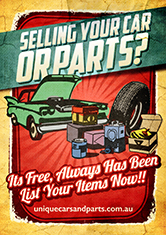Chrysler Cordoba
Reviewed by Unique Cars and Parts
Our Rating: 2
Introduction
The Chrysler Cordoba first appeared in 1975, a twin of the detuned, depowered Dodge Charger. Amusingly, it was originally meant to be a Plymouth, rather than a Chrysler; that was a last-minute change.
The Cordoba was then a B-body, one step in size above the entry-level Valiant A-body, but below the C and D bodies that usually wore the Chrysler badge. Styling was clearly GM-inspired.
Over half of the Chryslers built in that first year were Cordobas, and for good reason: like the Cadillac Catera or Lexus ES300, the Cordoba had a luxury name and a luxury feel, along with "normal car" price.
For just over $5,000, a buyer could say with pride that they owned a Chrysler, back in the days when Chrysler ranked with Lincoln and Cadillac (or, at least, with
Oldsmobile).
As one would expect, the Cordoba had many engine options - pretty much every contemporary V8 was available, from the 318 up to the 400. The base engine was the 318 V8 with "Lean Burn" system coupled with a TorqueFlite automatic, which did not exactly make the 3,895 lb car a hot performer.
Like the nearly-identical Charger SE, it could also be ordered with a four-barrel 360 or 400ci. V8 (with two or four barrel carburettors). Performance wasn't bad for the time, but would be frowned on today - the 400 did 0-100 in roughly 12 seconds. On the lighter side, strong torque meant instant acceleration once at speed.
The
suspension incorporated longitudinal front
torsion bars with lower trailing links and an anti-sway bar, coupled with semi-elliptical rear springs and a rear anti-sway bar. This provided the large, heavy car with surprisingly good handling. A standard lockup torque converter appeared in 1979 on most vehicles.
Despite annual styling and option changes, the early Cordobas remained similar in appearance and substance through 1979. They were joined in
1977 by the Dodge Magnum XE and XS, and in 1980 by the virtually identical Dodge Mirada. Cordoba in 1978 saw many changes under the skin in the name of saving weight, and a power sunroof was made optional; only a single model, a two door hardtop, was available.
The base engine was a new 318 with four barrel carb and Lean Burn system, with the 360 optional (in both two and four barrel carb versions) as well as the 400 V8. The wheelbase was a modest 115 inches, not much more than the "compacts." Cordoba was popular for a Chrysler in 1978 with 112,000 sales. In 1980, the Cordoba shifted platforms, joining the LeBaron and Dodge Mirada on a shorter wheelbase. This new "J-body" (E had been taken by the Barracuda, F by the Volare and Aspen) was decontented, part of the slow decline of the Chrysler label.
No longer was a V8 standard, though the slant six could hardly be said to provide luxury-style acceleration on this heavy car. The appearance changed completely, moving from the rounded look of the first models to a more contemporary, square look, complete with front fins. This second incarnation carried through to 1983.




It's got the 225 'Super Six' and gets 22 mpg on the city/highway commute in the summer and 18 mpg on the same commute in the winter. It's not a hot rod, it's a good-lookin' cruiser, gets a lot of
"Wow, Nice car! Is it for sale?" when I park it at malls.
Jim